Tim came over for part of the Fourth of July weekend . Our game of choice was not really in the spirit of the holiday. While we have played Red Star/White Eagles Eagle before, this weekend was an entirely new experience . Once again, Tim took the Poles.
Here’s a summary of the important rules/characteristics of the game.
- Bloody Combat Results Table (more on this later).
- Extended Movement After Combat (both advance and retreat).
- Strong Zones of Control for many Polish units (these can limit advances after combat and attrit defeated units retreating through the ZOC).
- Soviet Fronts cannot cooperate.
- Lack of traditional strong defensive positions (only forest and river lines that have exploitable gaps).River defensive positions lose their modifier if one attacking unit is not attacking across the river.
- Fronts separated by Pripet Marshes
- High reinforcement and replacements, especially for the Soviets.
- Four turns per month.
- Victory points awarded for capture of specific cities, only.
Tim arrived Friday afternoon having fought early holiday traffic and drivers of marginal capabilities . After sucking down three Henrys (each….I had to show solidarity), we set up and played three turns .
Play resumed the next morning. Right after we sat down Tim muttered , “You are going to hate me.” The initial set up was all wrong . Some might say alcohol had been involved , but the real culprit was the horrifically flawed set up diagram . Yes, it’s covered in the errata………
***Important Disclaimer*** I have absolutely no idea why all the photographs are canted. I am unaware of any body/head/eye bias that might have caused this. Also, the level of drinking was reasonable. May need tests.
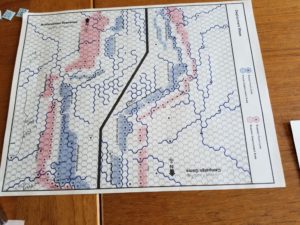
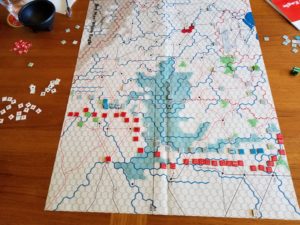
After we reset, things went from bad to worse for Tim. His southern front offensive staggered due to a series of D6 rolls of one. In this game a D6 role of one is not simply an exchange based on the defenders strength, it is an exchange where the attacker loses one half of its attacking force. At odds of 5:1 to 8:1 this is a staggering loss . In the past we assumed that the CRT was the same as that for Europa – after all the game’s mechanics are very similar to that system. The result was high levels of anxiety when rolling for an attack.
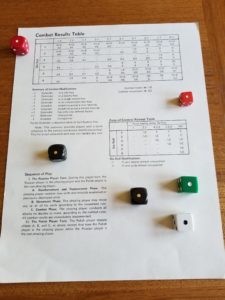
Tim’s rolls were so bad I gave him three Mulligans . While this might seem overly generous, I realized that this results table could cut both ways .
Despite this bad luck the Poles took Kiev .
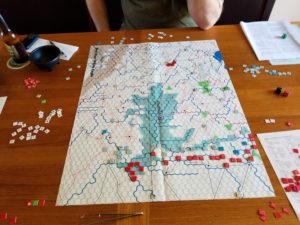
Early in the game almost all of the action occurs in the south . Both players are limited in their options in the north due to a mandated Red Army stand down .
The other defining aspect of the campaign game is the arrival in the south of the Konarmiya Cavalry Army on the May IV turn. This is a powerful force made even more dangerous due to a charge bonus which increases the value of its cavalry’s by fifty percent . A combination of the early stand down and appearance of the Konarmiya puts the Soviet player in the position to launch very strong offensives on both fronts beginning with the June I turn.
Anticipating this, the Poles began a series delay/defend actions covering the withdrawal of both fronts to more favorable defensive positions. He skillfully took advantage of the ZOC control of of withdrawals, using some units for the delay/defense.
Favorable is a subjective term in this game as there is very little rough or mountainous terrain on either side of the Pripet marshes . The river lines while affording some defensive bonuses have significant gaps which can be flanked .
The Poles were subjected to a number of aggressive attacks, with the Soviets focused on flanking Polish units. The Soviet player can afford to be aggressive due to a very high rate of both reinforcements and replacements. And, yes, I had use those Mulligans.
We called it quits after the July II turn. The Poles’ only hope was to hold on for another ten turns, when the Konarmiya must withdraw. Any destroyed Konarmiya units have to be replaced by other units, which could significantly attrit the Soviet forces. At that point, the Poles have only one turn to advance and grab as many cities as possible.
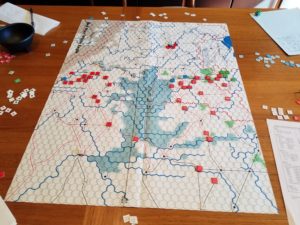
The terms Tim and used most often when playing were “weird” and “crazy”. The CRT is a little different, the die rolling was crazy, but it was an interesting game.